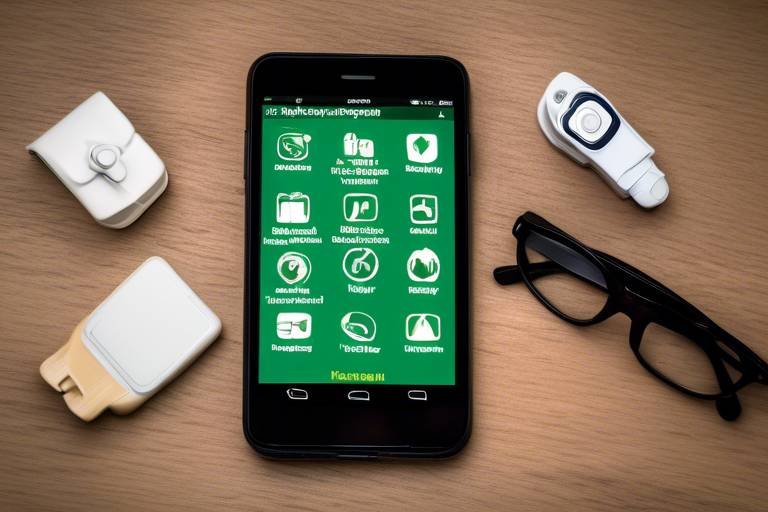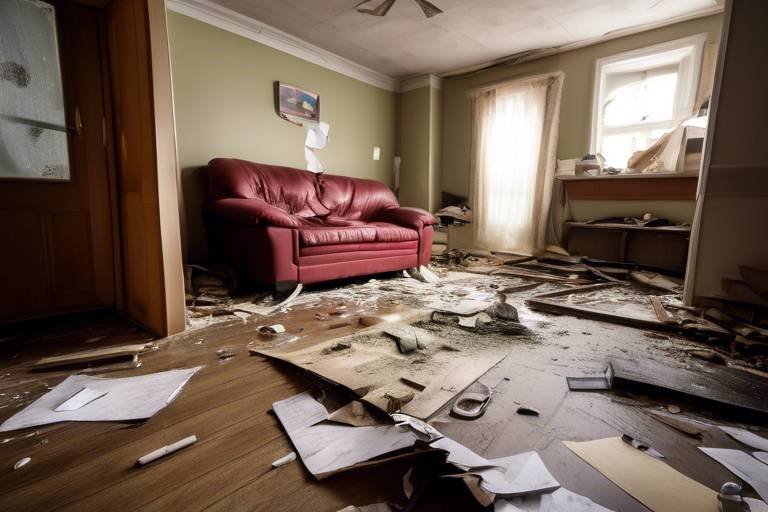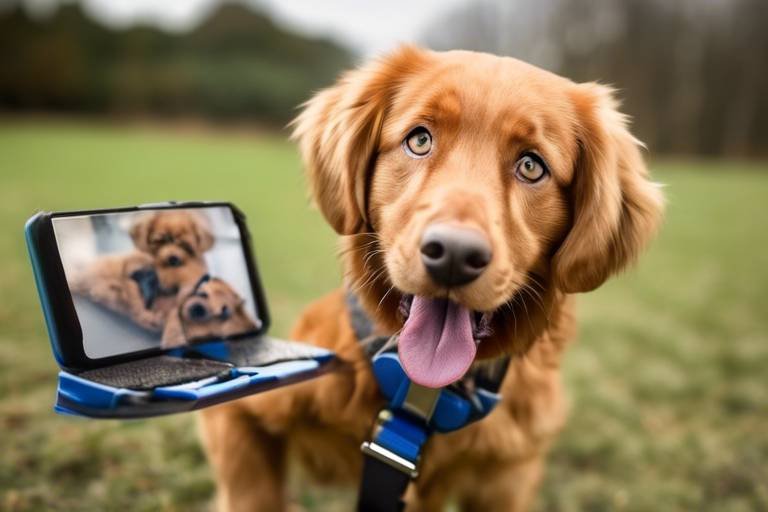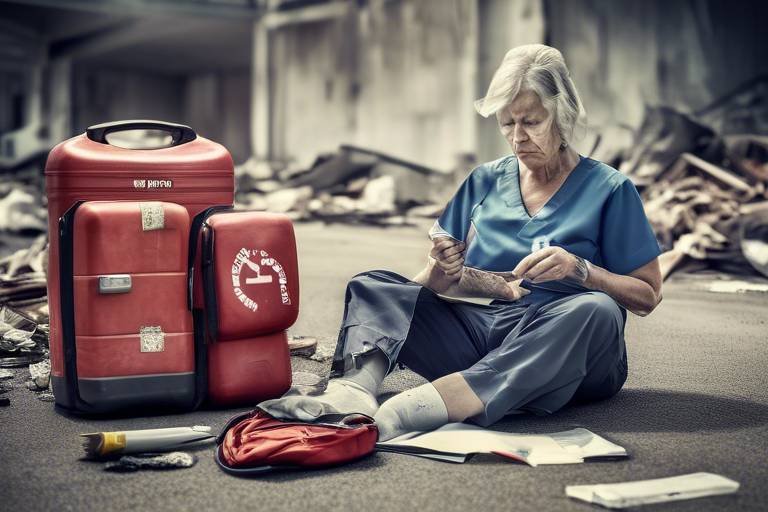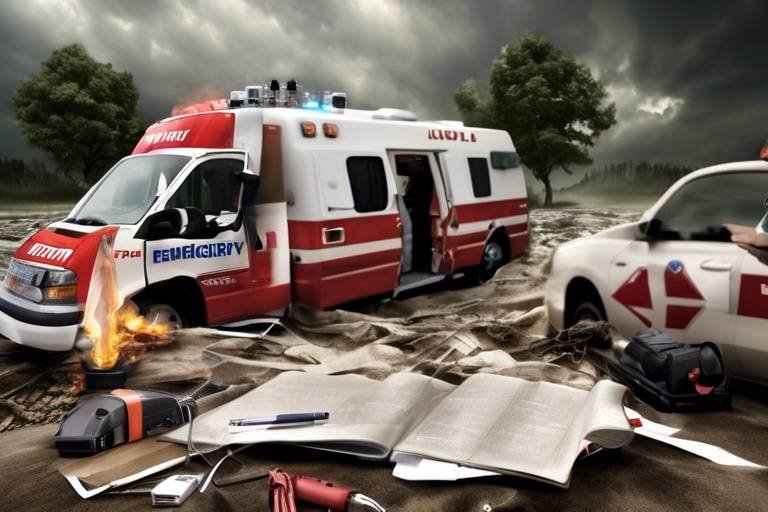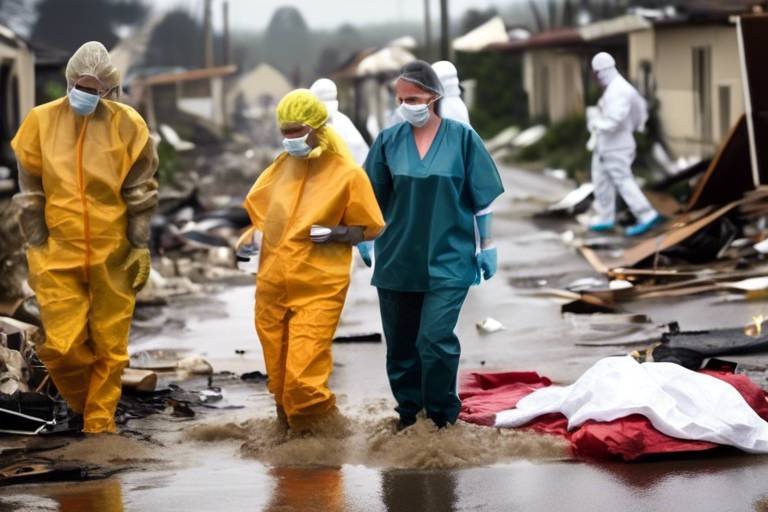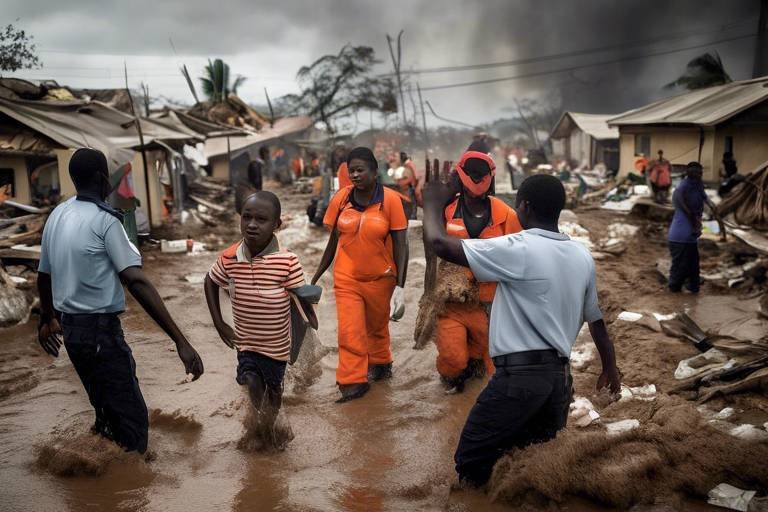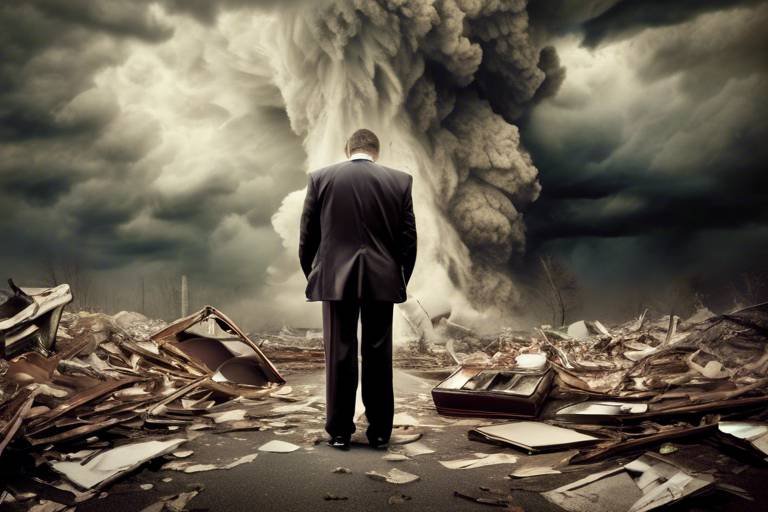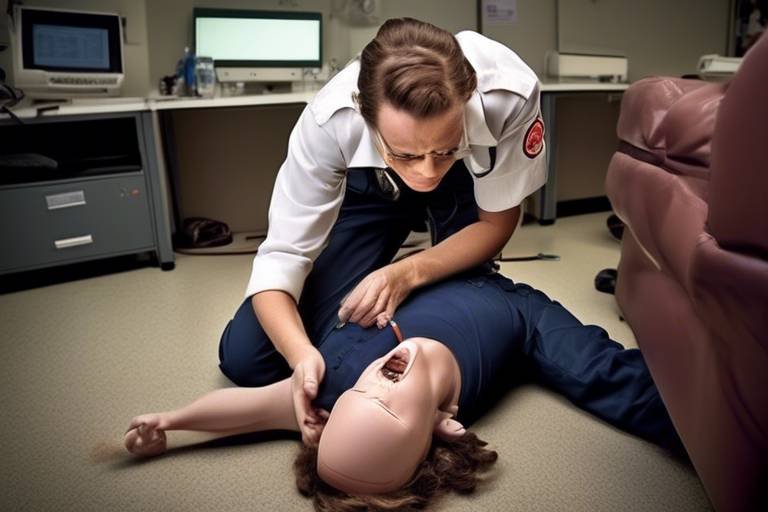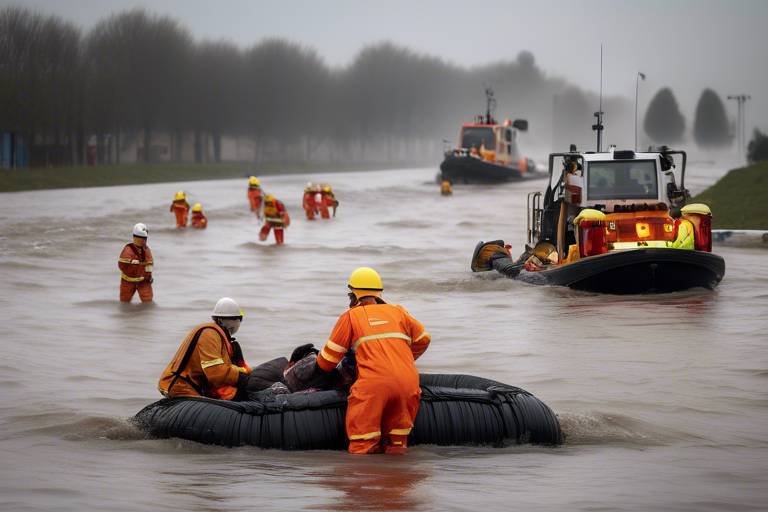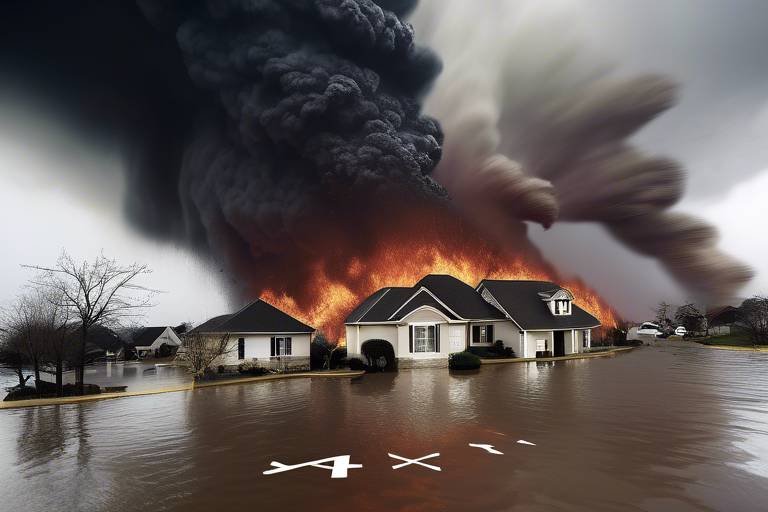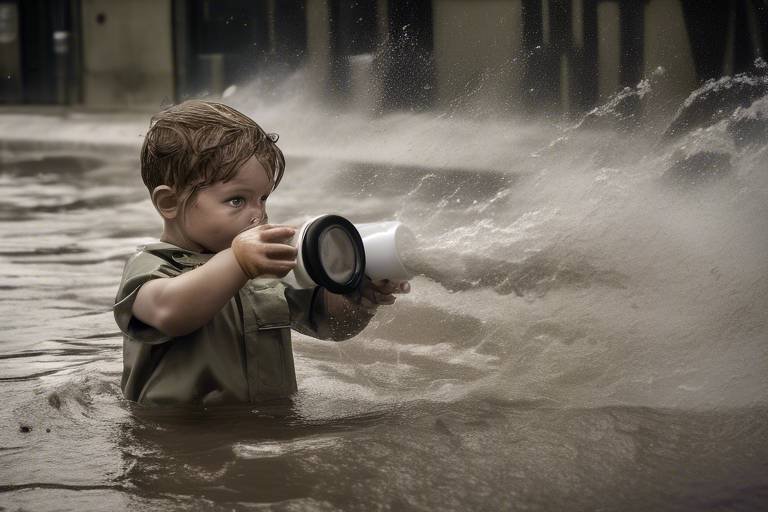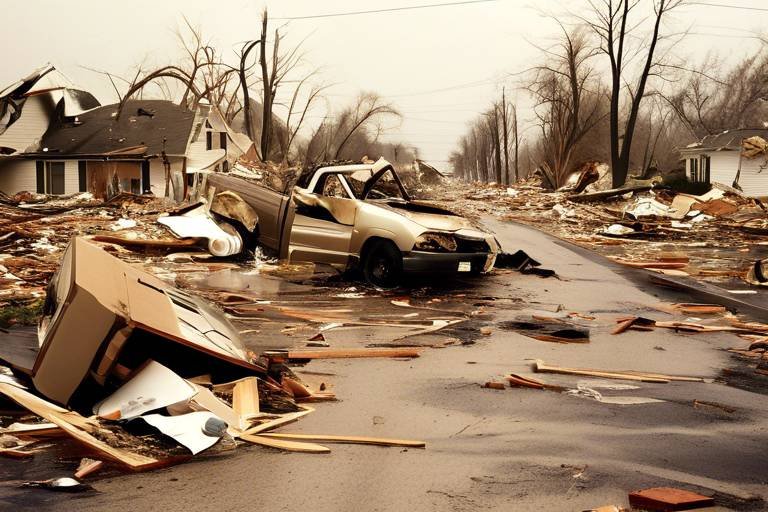Essential Smartphone Features for Emergency Preparedness
In today's fast-paced world, emergencies can strike at any moment, and being prepared is more crucial than ever. Our smartphones have evolved into powerful tools that can help us navigate through unexpected situations with ease. But what are the essential features that can enhance our emergency preparedness? In this article, we will explore various smartphone functionalities that ensure users are equipped to handle crises effectively and efficiently. From battery management to emergency apps, we'll cover everything you need to know to make your smartphone a reliable companion during emergencies.
Understanding battery longevity and efficient power management is vital for maintaining smartphone functionality during emergencies when access to charging may be limited. Imagine being in a situation where your phone is your only lifeline, and it runs out of juice! To prevent this, it's essential to know how to optimize your device's battery life. You can do this by adjusting screen brightness, closing unused apps, and utilizing battery saver modes. Also, consider investing in a portable charger or a power bank. This way, you can keep your phone charged and ready to go, even in the most challenging circumstances.
Your smartphone can be a lifesaver when it comes to receiving critical emergency alerts and notifications. Configuring these settings ensures you stay informed about local hazards and emergency situations. Have you ever thought about how many alerts you might be missing? By taking a few moments to customize your alert settings, you can prioritize notifications that matter most to you. This means when an emergency strikes, you’ll be among the first to know, allowing for timely responses that could make all the difference.
Users can personalize alert settings to prioritize notifications that matter most, allowing for timely responses during emergencies. You can choose to receive alerts from various sources, including weather services and local authorities. This customization enables you to filter out noise and focus on what truly matters. For instance, if you're in a flood-prone area, setting up alerts for weather warnings can provide you with the crucial information you need to act quickly.
Different types of alerts, such as weather warnings and public safety notifications, can be enabled for comprehensive emergency awareness. Here are some examples of alerts you might consider:
- Severe Weather Alerts: Stay updated on storms, hurricanes, or tornadoes.
- Public Safety Notifications: Receive information about local emergencies, such as fires or hazardous materials.
- Amber Alerts: Be notified about missing children in your area.
Understanding how to manage the Do Not Disturb feature ensures important alerts are not missed during critical times. It's easy to forget that while you might want peace and quiet, emergencies don’t adhere to our schedules. Make sure to allow notifications from emergency services and key contacts to come through, even when your phone is set to silent mode.
Location services and GPS functionality are essential for navigation and locating resources during emergencies. Picture this: you’re in an unfamiliar area during a natural disaster, and you need to find the nearest shelter. Your smartphone's GPS can guide you there, providing you with crucial information when you need it most. Additionally, sharing your location with friends or family can ensure that someone knows where you are in case of an emergency.
Various applications can enhance emergency preparedness, offering resources such as first aid guides, emergency contacts, and local emergency services. These apps can act as your personal safety toolkit, ready to assist you when the unexpected happens. For instance, a first aid app can provide step-by-step instructions on how to handle medical emergencies, ensuring that you can act quickly and effectively.
First aid apps provide vital information on handling medical emergencies. Whether it’s a sprain, a burn, or something more serious, having this information at your fingertips can make a significant difference. These apps often feature interactive guides and videos that can help you understand what to do in various situations, making them invaluable during a crisis.
Weather and disaster management apps keep users informed about severe weather conditions and natural disasters. With real-time updates, these apps enable proactive safety measures, allowing you to plan ahead and avoid potential dangers. Imagine receiving a notification about an approaching storm and having the time to prepare or evacuate if necessary!
In emergencies, internet access may be compromised. Understanding offline features, such as downloaded maps and essential documents, can be lifesaving. It’s not just about having the right apps; it’s about being prepared when connectivity fails. Ensure that you have crucial information stored on your device that can be accessed without an internet connection.
Downloading maps for offline use ensures navigation is possible even without a data connection, which is crucial during emergencies. Many mapping apps allow you to save specific areas for offline access. This feature can help you find your way when the roads are closed or if cell towers are down.
Storing essential documents, such as identification and medical information, on your smartphone allows quick access during emergencies without needing physical copies. You can use secure apps to store scanned copies of your ID, insurance cards, and medical records, ensuring that you have everything you need at your fingertips.
Q: What should I do if my phone's battery runs out during an emergency?
A: Always carry a portable charger or power bank to ensure your phone stays charged. Additionally, familiarize yourself with power-saving modes to extend battery life.
Q: How can I make sure I receive emergency alerts?
A: Check your phone's settings to enable emergency alerts and customize them based on your location and preferences.
Q: What are the best apps for emergency preparedness?
A: Some highly recommended apps include first aid guides, weather alerts, and local emergency services apps. Explore options that suit your needs.

Battery Life and Power Management
When it comes to emergency preparedness, one of the most crucial aspects of your smartphone is its battery life. Imagine being in a situation where you need your phone the most—perhaps during a natural disaster or a medical emergency—and your battery dies. It’s a nightmare scenario that can be avoided with a little foresight and understanding of how to manage your device’s power effectively. A smartphone that can last through critical moments can be a lifesaver, quite literally!
First off, let's talk about the importance of battery longevity. Most smartphones today come equipped with features designed to help you maximize battery life. This includes options like power-saving modes which limit background processes and reduce screen brightness. Activating these modes can extend your battery life significantly, giving you precious extra hours when you need them the most. But how do you know when to activate these features? It's best to do so before an emergency arises, ensuring your phone is always ready to assist you.
Another important aspect of power management is understanding your phone's charging habits. Are you the type who charges your phone overnight, or do you wait until it’s nearly dead? The truth is, maintaining a good charging routine can enhance your battery’s lifespan. For instance, keeping your battery level between 20% and 80% is often recommended to prevent wear and tear. Additionally, consider investing in a portable charger or a power bank. This way, you can ensure that you have backup power when you’re on the go and may not have access to an outlet.
Moreover, let’s not forget the impact of screen brightness on battery life. Dimming your screen or using automatic brightness settings can significantly conserve power. In emergencies, every little bit counts, and a dimmer screen can help you stay connected longer. Some smartphones even allow you to customize your display settings for different situations, so take advantage of these features!
In summary, effective battery management is about being proactive. Here are a few quick tips to keep your smartphone charged and ready:
- Use power-saving modes whenever possible.
- Maintain a healthy charging routine to prolong battery life.
- Invest in a portable charger for emergencies.
- Adjust your screen brightness to conserve energy.
By understanding and implementing these battery-saving techniques, you can ensure that your smartphone remains functional during emergencies. After all, your phone is not just a communication device; it's a lifeline that can provide you with critical information, connect you to emergency services, and even help you navigate to safety. So, take charge of your battery life today, and be prepared for whatever life throws your way!

Emergency Alerts and Notifications
In today's fast-paced world, staying informed during emergencies is more crucial than ever. Smartphones have become invaluable tools for receiving emergency alerts and notifications. These alerts can range from severe weather warnings to local safety notifications, helping users stay aware of potential dangers. By configuring your smartphone's settings, you can ensure that you receive timely and relevant information that could make all the difference in an emergency situation.
When it comes to emergency alerts, it’s not just about receiving notifications; it’s about understanding how to customize them to fit your needs. Imagine you're at home during a storm, and your phone buzzes with a weather alert. If you’ve set it up correctly, you’ll know exactly what to do next—whether to evacuate, seek shelter, or simply stay informed. This level of preparedness can transform your smartphone from a mere communication device into a lifeline.
Personalizing your alert settings is a game changer. Most smartphones allow you to prioritize notifications based on your preferences. For instance, you might want to receive immediate alerts for severe weather but can defer less critical notifications until later. This way, your phone becomes a tailored tool for your safety, filtering out the noise while keeping you informed about what truly matters.
There are several types of alerts that you can enable on your smartphone. These include:
- Weather Warnings: Alerts for severe storms, floods, and other weather-related emergencies.
- Public Safety Notifications: Information about local hazards, such as chemical spills or active shooter situations.
- Amber Alerts: Notifications about missing children in your area.
Each of these alerts serves a specific purpose and can help you react promptly to various situations. By enabling them, you’re not just relying on your instincts; you’re leveraging technology to keep yourself and your loved ones safe.
One feature that many users overlook is the Do Not Disturb function. While it’s great for minimizing distractions during meetings or at night, it can also prevent important alerts from coming through. Understanding how to manage this feature is essential, especially during critical times. You can customize the settings to allow emergency alerts to bypass the Do Not Disturb mode, ensuring that you’re always reachable when it counts.
In the end, the key takeaway is that your smartphone can be a powerful ally in emergency preparedness. By taking the time to configure your emergency alerts and notifications, you’re not just enhancing your own safety; you’re also empowering those around you. So, the next time you hear that familiar buzz, you’ll know it’s not just another notification—it could be a lifeline.

Customizing Alert Settings
In the world of smartphones, is not just a luxury; it's a necessity, especially when it comes to emergency preparedness. Imagine you're in the middle of a hectic day, and suddenly a critical weather alert pops up on your screen. If your phone is set to silent or Do Not Disturb mode, you might miss that vital information. By taking a few moments to tailor your alert settings, you can ensure that you stay informed and ready to act when it matters the most.
First things first, let’s talk about the various types of alerts you can customize. Most smartphones allow you to receive alerts for emergencies like severe weather warnings, public safety notifications, and even local news updates. By prioritizing these alerts, you can filter out the noise and focus on what truly matters during a crisis. For instance, you might want to enable notifications for:
- Severe weather warnings
- Amber alerts
- Emergency broadcasts from local authorities
By selecting which alerts to prioritize, you can create a personalized safety net that keeps you informed without overwhelming you with unnecessary notifications.
Another crucial aspect to consider is the Do Not Disturb feature. While it’s great for blocking out distractions during meetings or quiet time, it can also prevent important alerts from coming through. Make sure to customize your Do Not Disturb settings to allow emergency alerts to bypass this mode. Most smartphones have options to allow specific notifications even when the device is silenced. This means you can enjoy some peace of mind without compromising your safety.
Additionally, each phone typically has a dedicated settings menu for alerts where you can choose the sound, vibration, and even the visual notifications that accompany these alerts. Some users prefer a loud, attention-grabbing sound, while others might opt for a subtle vibration. The key is to choose a setting that will grab your attention without causing panic. After all, you want to be alerted, not alarmed!
Finally, don't forget to regularly review your alert settings. As your life changes—whether it’s moving to a new area, changing jobs, or even just adjusting your daily routine—your alert preferences may need to change too. Set a reminder to check your settings every few months to ensure you're still receiving the most relevant alerts.
In summary, customizing alert settings on your smartphone is a simple yet effective way to enhance your emergency preparedness. By prioritizing vital alerts, managing your Do Not Disturb settings, and regularly reviewing your preferences, you can ensure that you’re always one step ahead in any emergency situation.
Q: How do I enable emergency alerts on my smartphone?
A: You can usually find emergency alert settings in the settings menu under "Notifications" or "Safety." Make sure to enable all relevant options for your area.
Q: Will I receive alerts if my phone is on silent?
A: It depends on your settings. Many smartphones allow emergency alerts to bypass silent mode, but you'll need to check your Do Not Disturb settings to ensure this feature is activated.
Q: Can I customize the sound of emergency alerts?
A: Yes! Most smartphones allow you to choose different sounds or vibrations for different types of alerts, so you can select one that suits your preferences.
Q: How often should I check my alert settings?
A: It's a good idea to review your alert settings every few months or whenever you experience a significant life change, such as moving to a new area.

Types of Alerts
When it comes to emergency preparedness, understanding the that your smartphone can receive is crucial. These alerts serve as lifelines during critical situations, providing timely information that can make a significant difference. Here’s a closer look at the various types of alerts you should configure on your device:
Among the most important alerts are weather warnings. These notifications inform you about severe weather conditions such as hurricanes, tornadoes, floods, or blizzards. By staying updated on weather alerts, you can take necessary precautions to protect yourself and your loved ones. For instance, if a severe thunderstorm warning is issued, you might want to secure outdoor items and stay indoors until the threat passes.
Another vital category is public safety notifications. These alerts are typically issued by local authorities and can inform you about emergencies such as active shooter situations, chemical spills, or other public safety threats. Having these notifications enabled ensures that you receive real-time updates, allowing you to make informed decisions quickly.
Additionally, Amber Alerts are crucial for community safety. These alerts are issued when a child is abducted, providing details about the child, the suspected abductor, and any vehicle involved. By being aware of these alerts, you can keep an eye out and potentially assist in locating the child.
Moreover, there are emergency alerts related to natural disasters such as earthquakes or tsunamis. These alerts often come with specific instructions on what actions to take, whether it's to evacuate, seek shelter, or prepare for aftershocks. Understanding these alerts can be the difference between safety and danger.
To make sure you never miss an important notification, it’s essential to customize your alert settings. You can prioritize which notifications matter most to you. For example, while weather alerts might be your top priority, you may want to adjust the frequency of Amber Alerts based on your location and personal preferences.
Lastly, if you’re in an area prone to emergencies, consider enabling local alerts from your municipality. These can include fire department notifications, road closures, or community alerts regarding public health issues. Staying informed about local conditions can empower you to act swiftly when needed.
In summary, the types of alerts your smartphone can provide are diverse and crucial for emergency preparedness. By ensuring that you have the right alerts configured, you can stay informed and ready to act in the face of unexpected situations.
- How can I enable emergency alerts on my smartphone? Most smartphones have a settings option under 'Notifications' or 'Emergency Alerts' where you can toggle these alerts on or off.
- Are all emergency alerts free? Yes, emergency alerts sent by government agencies or local authorities are free of charge.
- What should I do if I receive an emergency alert? Follow the instructions provided in the alert. Stay informed through news outlets and social media for updates.
- Can I customize the types of alerts I receive? Absolutely! Most smartphones allow you to customize which alerts you want to receive based on your preferences.

Managing Do Not Disturb
In today's fast-paced world, the Do Not Disturb (DND) feature on smartphones can be a double-edged sword, especially during emergencies. While it serves as a great tool to minimize distractions and maintain focus, it can also lead to missing critical alerts when every second counts. Imagine being in a situation where you need timely updates about a natural disaster, yet your phone is silenced. Understanding how to effectively manage this feature can make a significant difference in your emergency preparedness.
First and foremost, it's essential to know that most smartphones allow users to customize their DND settings. This means you can allow certain notifications to break through the silence, ensuring that you stay informed about urgent matters. For instance, you might want to permit calls from specific contacts, like family members or close friends, while silencing all other notifications. This way, if someone important is trying to reach you during an emergency, their call will come through, while less critical notifications remain muted.
Additionally, many smartphones offer the option to schedule DND times. This feature can be particularly useful if you anticipate being in a situation where you won't need constant notifications, like during a meeting or while sleeping. However, during unpredictable events, such as severe weather alerts or emergencies, it’s wise to turn off the scheduled DND mode or adjust it to allow for urgent notifications. Here’s how you can manage it:
- Accessing DND Settings: Navigate to your phone's settings and locate the DND feature. This is often found under 'Sound' or 'Notifications.'
- Allowing Exceptions: Look for options to allow calls or messages from specific contacts or repeated calls (which indicates urgency).
- Temporary DND: Some devices offer a temporary DND mode that can be activated for a set period, making it easy to silence notifications without forgetting to turn it off later.
It's also important to regularly review your DND settings, especially before heading into situations where you might need to be on high alert. Emergencies are unpredictable, and being proactive about how your phone communicates with you during these times is crucial. Furthermore, many smartphones provide visual notifications, like flashing lights or vibrations, even when DND is activated. Familiarizing yourself with these features can ensure you don't miss vital alerts.
In summary, managing the Do Not Disturb feature effectively is a key component of emergency preparedness. By allowing important notifications to come through while silencing the rest, you can strike a balance between maintaining focus and staying informed. Remember, your smartphone is not just a communication device; it’s a lifeline during critical moments. So, take the time to tailor your DND settings to fit your needs and ensure you’re ready for whatever life throws your way!
Q: How can I customize my Do Not Disturb settings?
A: You can customize your DND settings by going to your phone's settings, selecting 'Sound' or 'Notifications,' and adjusting the DND preferences according to your needs. You can allow calls from specific contacts or enable notifications from certain apps.
Q: Will I still receive emergency alerts if Do Not Disturb is on?
A: Most smartphones are designed to allow emergency alerts to come through even if DND is activated. However, it’s best to check your settings to ensure that this feature is enabled.
Q: Can I schedule Do Not Disturb times?
A: Yes, many smartphones allow you to schedule DND times. This feature can help you manage notifications during specific periods, like when you’re sleeping or in meetings.
Q: What should I do if I miss an important alert?
A: If you miss an alert, check your notification center or alerts log to see if any important notifications were received while DND was active. Regularly reviewing your settings can help prevent this in the future.

Location Services and GPS
When it comes to emergency preparedness, having reliable location services and GPS functionality on your smartphone is nothing short of essential. Imagine being in an unfamiliar area during a natural disaster or needing to find the nearest hospital in a medical emergency. Your smartphone's GPS can act as your guiding star, helping you navigate through chaos with ease. This technology not only provides directions but also offers critical information about your surroundings, ensuring you can locate resources quickly.
Location services utilize satellite technology to pinpoint your exact location, which is incredibly useful in emergencies. For instance, if you're in a situation where you need to call for help, sharing your location with emergency services can drastically reduce response time. They can find you faster if they know where you are. Furthermore, many emergency apps leverage this functionality to provide users with real-time updates and alerts relevant to their specific area. This means you can receive notifications about hazards or safety measures tailored to your exact location.
However, it's important to understand how to enable and manage these features effectively. Here’s a quick overview of what you should consider:
- Enable Location Services: Ensure that your location services are turned on, as this will allow apps to access your GPS data.
- Check App Permissions: Review which apps have access to your location. Prioritize those that are crucial for emergency preparedness.
- Battery Management: GPS can drain your battery quickly, so knowing how to manage your phone's power settings is key during emergencies.
In addition to these practical aspects, many smartphones now come equipped with features that enhance GPS functionality. For example, some devices offer offline maps, which can be a lifesaver if you find yourself without an internet connection. By downloading maps in advance, you can ensure that you have a reliable navigation tool at your fingertips, even in the most challenging situations.
Moreover, the integration of location sharing features enables you to inform friends or family about your whereabouts. In case of an emergency, you can quickly share your location via messaging apps or social media, increasing the chances of getting help when you need it most. This feature can also be useful for keeping track of loved ones during widespread emergencies, such as natural disasters.
In summary, understanding and utilizing location services and GPS on your smartphone can significantly enhance your emergency preparedness. It provides you with the tools to navigate effectively, share your location with emergency services, and access vital information when every second counts. So, before you head out, take a moment to familiarize yourself with these features—your future self will thank you!

Emergency Apps and Resources
In today's fast-paced world, being prepared for emergencies is more important than ever. One of the best ways to enhance your preparedness is through the use of available on your smartphone. These apps can provide critical information and support in various situations, ensuring that you are not left in the dark when it matters most. Imagine being caught in a severe storm or facing a medical emergency; having the right apps on your phone can be the difference between chaos and calm.
There are a plethora of apps designed to assist users during emergencies, ranging from first aid guides to local emergency service contacts. These applications not only offer valuable information but also empower users to take action when needed. For instance, first aid apps can guide you through essential medical procedures, helping you respond effectively until professional help arrives. In moments of crisis, this kind of knowledge can be incredibly reassuring.
Another category of essential apps includes weather and disaster management applications. These apps keep you updated on severe weather conditions, allowing you to make informed decisions about your safety. For example, a weather app can provide real-time alerts about approaching storms, giving you ample time to secure your home and make necessary preparations. With features like radar maps and severe weather warnings, these apps serve as your personal safety net.
To illustrate the variety of emergency apps available, here's a quick overview of some popular categories:
| App Type | Purpose | Examples |
|---|---|---|
| First Aid | Provides guidance on medical emergencies | Red Cross First Aid, St. John Ambulance First Aid |
| Weather | Offers real-time weather updates and alerts | Weather Underground, AccuWeather |
| Emergency Contacts | Stores important contacts for quick access | Emergency Contacts Pro, ICE - In Case of Emergency |
When selecting emergency apps, consider your specific needs and the types of emergencies you might face. For example, if you frequently travel, having a reliable navigation app that works offline can be invaluable. Similarly, if you live in an area prone to natural disasters, downloading a disaster management app can provide you with critical alerts and resources tailored to your location.
Moreover, many of these apps allow you to customize settings to suit your preferences. For instance, you can choose which notifications to receive, ensuring that you are alerted only about the emergencies that matter most to you. This level of personalization can help reduce the noise of unnecessary notifications, allowing you to focus on what’s truly important.
In summary, equipping your smartphone with the right emergency apps and resources can significantly enhance your preparedness for unexpected situations. By taking the time to explore and install these applications, you are not just preparing for emergencies; you are empowering yourself with knowledge and tools that could save lives. So, why wait? Start downloading today and take control of your safety!
Q: What types of emergency apps should I have on my smartphone?
A: It's advisable to have a mix of first aid apps, weather alert apps, and emergency contact apps. This combination ensures you are prepared for medical emergencies, severe weather, and can quickly reach out for help.
Q: Can I use these apps without an internet connection?
A: Many emergency apps offer offline functionality, allowing you to access essential information even when you don't have internet access. It's crucial to check the app specifications before downloading.
Q: How do I ensure I receive important alerts?
A: Customize your notification settings within the apps to prioritize alerts that are most relevant to you. Additionally, ensure that your smartphone's settings allow notifications from these apps.

First Aid and Safety Apps
In today's fast-paced world, being prepared for emergencies is more important than ever. One of the most effective ways to ensure you are ready to tackle unexpected situations is by leveraging technology, specifically through . These mobile applications serve as your pocket-sized guide to emergency response, providing critical information right when you need it. Imagine having a lifeline of knowledge at your fingertips, ready to assist you whether you're facing a minor injury or a major crisis.
First aid apps are designed to be user-friendly and intuitive, making them accessible to everyone, regardless of their medical background. They often feature step-by-step instructions on how to handle various medical emergencies, from treating cuts and burns to performing CPR. For instance, some apps include interactive guides that use videos and animations to demonstrate proper techniques, ensuring that users can visualize the steps they need to take. This visual learning can be particularly beneficial in high-stress situations where clarity is crucial.
Moreover, many first aid apps allow users to customize their experience by adding emergency contacts and personal health information. This feature can be invaluable during a crisis, as it enables you to quickly share vital details with first responders or medical personnel. Imagine being able to provide your allergies, medications, and medical history with just a few taps on your screen. It’s like having a personal health assistant available 24/7!
In addition to first aid instructions, these apps often include other safety features, such as:
- Emergency Contacts: Quickly access and call your emergency contacts with just one tap.
- Location Sharing: Share your location with friends or family in case of an emergency.
- First Aid Kit Checklist: Keep track of supplies you need for your first aid kit.
Additionally, many first aid apps are developed in collaboration with reputable organizations, such as the Red Cross or other health agencies, ensuring that the information provided is accurate and reliable. This partnership not only enhances the credibility of the app but also gives users peace of mind knowing they are following guidelines from trusted sources.
As we navigate through our daily lives, the potential for accidents or emergencies is always present. Therefore, having a first aid app on your smartphone is not just a convenience; it's a necessity. The next time you find yourself in a situation where quick action is required, you’ll be grateful for the knowledge and resources that these apps provide. They empower you to take control of the situation, potentially saving lives—perhaps even your own.
Q1: Are first aid apps reliable?
Yes, many first aid apps are developed in collaboration with recognized organizations like the Red Cross, ensuring that the information is accurate and trustworthy.
Q2: Can I use these apps without an internet connection?
Some first aid apps allow you to download content for offline use, making them accessible even when you don't have internet connectivity.
Q3: Do I need medical training to use these apps?
No, first aid apps are designed to be user-friendly and provide step-by-step instructions that anyone can follow, regardless of their medical background.
Q4: Are there any costs associated with these apps?
While many first aid apps are free, some may offer premium features for a fee. Always check the app details before downloading.

Weather and Disaster Management Apps
In today's unpredictable world, staying informed about severe weather conditions and potential disasters is crucial for ensuring personal safety and preparedness. This is where come into play, acting as your digital lifeline during emergencies. These apps provide real-time updates, alerts, and forecasts that can significantly influence your decision-making process when disaster strikes.
Imagine you’re planning a weekend getaway, and suddenly, a storm warning pops up on your phone. With a reliable weather app, you can quickly assess the situation, make informed choices, and avoid dangerous conditions. These apps not only deliver weather forecasts but also offer crucial information about natural disasters, such as hurricanes, floods, and wildfires. By keeping you in the loop, these applications empower you to take proactive safety measures.
Many of these apps provide features such as:
- Real-time alerts: Get notified instantly about severe weather warnings or changes in conditions.
- Interactive maps: View radar images and track storm paths to stay one step ahead.
- Emergency preparedness tips: Access vital information on how to prepare for various disasters.
Moreover, the integration of GPS technology in these apps allows users to receive localized alerts tailored to their specific location. This means you won’t just get generic warnings; instead, you’ll receive information that is directly relevant to your area, helping you assess the risk more accurately. For instance, if a tornado warning is issued, you can quickly find the safest route to shelter, all thanks to the detailed maps and navigation features embedded within these apps.
Some popular weather and disaster management apps include:
| App Name | Key Features |
|---|---|
| Weather Underground | Hyper-local weather data, interactive radar, and severe weather alerts. |
| NOAA Weather Radar | National weather service alerts, radar imagery, and storm tracking. |
| FEMA App | Emergency preparedness resources, disaster resources, and safety tips. |
In conclusion, having a reliable weather and disaster management app on your smartphone is not just a convenience; it’s a necessity. These tools can mean the difference between staying safe and being caught off guard. So, make sure to download a couple of these apps and familiarize yourself with their features. Your future self will thank you when you find yourself navigating through an emergency situation with confidence and clarity.
Q: What are the best weather apps for emergency preparedness?
A: Some of the best weather apps include Weather Underground, NOAA Weather Radar, and the FEMA app, as they offer real-time alerts and comprehensive information on severe weather conditions.
Q: How do I customize alerts in my weather app?
A: Most weather apps allow you to customize alerts by accessing the settings menu. You can choose which types of notifications you want to receive, such as severe weather warnings or daily forecasts.
Q: Can I access these apps without an internet connection?
A: While some features may require an internet connection, many weather apps allow you to download radar images or forecasts for offline use, which can be invaluable during emergencies.

Offline Functionality
In today's world, where we rely heavily on internet connectivity, it's easy to overlook the importance of in our smartphones. However, during emergencies, when internet access may be compromised, having the ability to function offline can be a true lifesaver. Imagine being stranded in an unfamiliar area with no signal—this is where offline capabilities come into play. They can mean the difference between feeling helpless and being prepared.
One of the most crucial offline features is the ability to download maps for navigation. Many navigation apps allow users to save maps directly to their devices. This means that even if your data connection drops or you find yourself in a remote area, you can still find your way. To download offline maps, simply access your preferred mapping application, search for the area you need, and select the option to download for offline use. This way, you can have a reliable guide at your fingertips, even without the internet.
In addition to maps, storing important documents on your smartphone is another essential aspect of offline functionality. Imagine needing your medical records or identification in a crisis but not having access to physical copies. By saving these documents digitally, you ensure that you can access them quickly and easily. You can create a secure folder on your device or use a dedicated app that allows you to store sensitive information safely. Make sure to regularly update these documents to reflect any changes, such as new medications or emergency contacts.
Moreover, consider the benefits of having emergency contacts stored offline. In a situation where you need to reach out for help, having a list of contacts readily available can save precious time. You can create a note or a document that includes vital information such as phone numbers for family members, friends, or local emergency services. This way, you won’t have to scramble through your phone’s contact list, which might not be accessible if your phone is low on battery or if you’re in an area with poor reception.
To summarize, offline functionality is not just a convenience; it is a critical component of emergency preparedness. By taking the time to download maps, store important documents, and keep emergency contacts handy, you equip yourself with the tools needed to navigate unexpected situations. In a world where connectivity can be unpredictable, being prepared offline can make all the difference.
- What should I download for offline use? It's advisable to download maps, emergency contact information, and important documents such as medical records and identification.
- How do I ensure my documents are secure? Use password-protected folders or dedicated apps designed for storing sensitive information securely.
- Can I access offline maps without a data connection? Yes, once downloaded, offline maps do not require a data connection to be accessed.

Downloading Offline Maps
When it comes to emergency preparedness, one of the most crucial features your smartphone can offer is the ability to download offline maps. Imagine being in a situation where your internet connection is spotty or completely unavailable—like during a natural disaster or in remote areas. Without access to navigation tools, you could easily find yourself lost or unable to reach critical resources. This is where offline maps come into play, acting as your trusty compass in times of uncertainty.
Downloading offline maps is not just a simple task; it's a proactive measure that can save you time and stress when every second counts. Most mapping applications, such as Google Maps and Apple Maps, allow users to download specific areas for offline use. By doing this, you ensure that you have access to detailed routes, local landmarks, and essential services like hospitals and gas stations, even when your phone can't connect to the internet.
To download offline maps, follow these general steps:
- Open your preferred mapping application.
- Search for the area you want to download.
- Look for the option to download or save the map for offline use.
- Select the area you want to cover, ensuring it includes your expected routes and destinations.
- Confirm the download and wait for it to complete.
It's also important to regularly update your offline maps. Just like any other software, mapping applications receive updates that enhance their functionality and accuracy. By keeping your maps current, you can ensure that you have the latest information regarding road changes, closures, and new points of interest. This can be particularly beneficial in emergency situations where routes may be altered due to unforeseen circumstances.
In addition to downloading maps, consider saving important locations such as your home, workplace, and nearby emergency services. Most mapping apps allow you to create custom lists of saved locations, making it easier to navigate during a crisis. Remember, the more prepared you are, the better equipped you'll be to handle any situation that arises.
In summary, downloading offline maps is an essential step in your emergency preparedness plan. By taking a few moments to ensure you have access to detailed navigation tools, you can navigate through challenges with confidence and clarity, ultimately enhancing your safety and that of your loved ones.
Q: How do I know which areas to download for offline maps?
A: Consider downloading maps for areas where you live, work, or frequently visit, as well as any locations you plan to travel to, especially if they are remote or prone to emergencies.
Q: Will downloading offline maps use up my phone's storage?
A: Yes, offline maps do take up storage space, but most mapping applications allow you to manage and delete maps you no longer need.
Q: Can I use offline maps for navigation without a data connection?
A: Absolutely! Once downloaded, offline maps allow you to navigate without an active internet connection, making them invaluable during emergencies.

Storing Important Documents
In today's fast-paced world, the importance of having access to essential documents during emergencies cannot be overstated. Imagine being in a chaotic situation where every second counts, and the last thing you want is to rummage through a pile of papers or, worse, realize you left them at home. This is where your smartphone can be a game-changer. By storing important documents digitally, you can ensure that you have everything you need right at your fingertips.
But what exactly should you store on your smartphone? Here are some key documents that can be lifesavers:
- Identification: Keep a digital copy of your driver's license, passport, or any government-issued ID. This is crucial for verification purposes in emergencies.
- Medical Information: Store your medical records, including allergies, medications, and emergency contacts. This can be vital for first responders.
- Insurance Policies: Save copies of your health, auto, and home insurance policies. In case of an emergency, having this information handy can expedite claims and assistance.
- Emergency Contacts: Create a list of emergency contacts, including family members, friends, and local emergency services.
To make sure these documents are easily accessible, consider using cloud storage services such as Google Drive, Dropbox, or iCloud. These platforms not only allow you to store your documents securely but also enable you to access them from any device with internet connectivity. Furthermore, many of these services offer offline access, meaning you can view your documents even if you’re in an area with poor reception.
Additionally, ensure that your documents are well-organized within these applications. Create folders for different categories—like 'Medical', 'Identification', and 'Insurance'—to make navigation easier when time is of the essence. You can even label files clearly so that you can quickly find what you need without wasting precious seconds.
However, while digital storage is incredibly convenient, it’s also important to consider security. Make sure to use strong passwords and enable two-factor authentication on your storage accounts to protect your sensitive information from unauthorized access. After all, the last thing you want is for your personal documents to fall into the wrong hands during a crisis.
In conclusion, storing important documents on your smartphone is not just a smart move; it’s a necessary one. By taking the time to organize and secure your vital information, you’re not only preparing yourself for emergencies but also ensuring peace of mind. So, take a moment today to digitize those important papers, and you’ll be ready for whatever life throws your way!
Q: What types of documents should I store on my smartphone?
A: It's advisable to store identification documents, medical information, insurance policies, and emergency contacts for quick access during emergencies.
Q: How can I ensure my documents are secure?
A: Use strong passwords, enable two-factor authentication, and consider encrypting sensitive files to protect them from unauthorized access.
Q: Can I access my documents offline?
A: Yes, many cloud storage services allow you to download documents for offline access, ensuring you can retrieve them even without internet connectivity.
Frequently Asked Questions
- What smartphone features are essential for emergency preparedness?
Essential features include long battery life, emergency alerts, GPS and location services, offline functionality, and access to emergency apps. These tools ensure you can stay informed and navigate effectively during unexpected situations.
- How can I improve my smartphone's battery life during emergencies?
To enhance battery life, enable power-saving modes, reduce screen brightness, and close unnecessary apps. Keeping your phone charged and carrying a portable charger can also be lifesavers when you're out and about.
- What types of emergency alerts can I receive on my smartphone?
You can receive various alerts such as weather warnings, public safety notifications, and local hazard alerts. Configuring your settings to prioritize these notifications ensures you won't miss critical information.
- How do I customize alert settings on my smartphone?
You can customize alert settings by going into your phone's settings menu, navigating to notifications, and selecting which alerts you want to receive. This way, you can focus on the alerts that matter most to you.
- Why is GPS important during emergencies?
GPS functionality helps you navigate to safety, locate emergency services, and find resources like shelters or hospitals. It’s your digital compass when every second counts!
- What emergency apps should I download?
Consider downloading first aid apps, weather monitoring apps, and local emergency service apps. These resources can provide crucial information and guidance when you need it most.
- How can I ensure I have access to important documents offline?
You can store important documents, such as IDs and medical information, in secure cloud storage or directly on your device. Just make sure they are accessible even when your internet connection is down!
- Can I use maps without internet access?
Absolutely! By downloading offline maps before heading out, you can navigate without needing a data connection. This is especially useful in emergencies when service may be spotty.
- What should I do if I miss an emergency alert?
If you miss an alert, check your notification settings and ensure they are properly configured. It's also a good idea to stay connected with local news sources or community alerts to stay informed.

